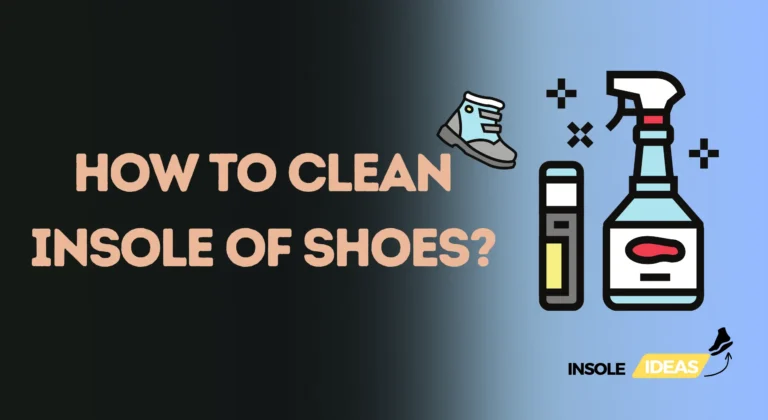Mastering Insole Cleaning: A Step-by-Step Guide
Insoles play a vital role in footwear comfort and hygiene. However, they often bear the brunt of our daily activities, accumulating dirt, sweat, and odor over time. In addition to extending the life of your shoes, proper cleaning and upkeep also improves general hygiene and foot health. This step-by-step guide elucidates the importance of clean insoles and provides comprehensive insights into the process of mastering insole cleaning.
I. Introduction
A. Importance of Clean Insoles
Clean insoles are paramount for foot health and overall well-being. Frequent washing stops germs and fungus from growing, which can cause infections, a variety of skin disorders, and bad foot odor. Moreover, maintaining clean insoles prolongs the freshness of your shoes, enhancing comfort and eliminating unpleasant odors.
B. Common Issues Caused by Dirty Insoles
Dirty insoles can give rise to several problems, including persistent foot odor, fungal infections such as athlete’s foot, and bacterial growth. Additionally, unclean insoles may contribute to shoe degradation and discomfort, detracting from the overall wearing experience.
II. Understanding Insoles
A. Types of Insoles
Insoles come in various materials, each offering distinct benefits and features tailored to specific needs:
1. Gel Insoles
Gel insoles provide superior cushioning and shock absorption, making them ideal for individuals with high arches or foot pain. These insoles are designed to alleviate pressure points and enhance overall comfort during prolonged wear.
2. Foam Insoles
Foam insoles offer excellent support and contouring, conforming to the unique shape of the foot for enhanced stability and comfort. They are lightweight, breathable, and suitable for everyday use in a variety of footwear.
3. Leather Insoles
Leather insoles combine durability with moisture-wicking properties, effectively regulating temperature and preventing the accumulation of sweat and odor. These insoles offer premium comfort and are often found in high-quality footwear.
B. Signs of Dirty Insoles
Identifying dirty insoles is essential for maintaining foot hygiene and preventing potential health issues. Common indicators include visible dirt or stains, unpleasant odors, and discoloration. Additionally, persistent foot discomfort or itching may signify the presence of microbial growth within the insoles.
III. Preparing for Cleaning
Before embarking on the cleaning process, adequate preparation is essential to ensure optimal results and preserve the integrity of the insoles.
A. Removing Insoles Properly
Carefully remove the insoles from the shoes to facilitate thorough cleaning and prevent damage to the footwear. Avoid using excessive force or pulling on the insoles, as this may cause tearing or deformation.
B. Checking Manufacturer’s Instructions
Refer to the manufacturer’s guidelines for specific cleaning instructions tailored to the type of insoles and materials used. Adhering to these recommendations helps maintain warranty coverage and ensures effective cleaning without compromising the integrity of the insoles.
C. Gathering Cleaning Supplies
Assemble the necessary cleaning supplies, including:
1. Mild Soap
Opt for a gentle, pH-balanced soap to avoid harsh chemicals that may damage the insoles or cause skin irritation.
2. Soft Brush
Choose a soft-bristled brush to gently remove dirt and debris from the surface of the insoles without causing abrasions or damage.
3. Water
Use lukewarm water to facilitate the cleaning process and effectively dissolve dirt and stains from the insoles.
4. Towels
Prepare clean, absorbent towels for drying the insoles after cleaning, ensuring thorough moisture removal and preventing mold or mildew growth.
Quick Cleaning Methods
Maintaining clean insoles doesn’t always require an extensive process. Quick cleaning methods offer convenient solutions to eliminate surface dirt, odors, and bacteria, ensuring freshness and comfort with minimal effort.
A. Dry Brushing
Dry brushing is the process of carefully cleaning the insoles’ surface of debris, loose particles, and grime with a soft-bristled brush. To keep insoles clean and free of impurities, use this procedure which works well for routine maintenance. You may do it every day or as needed.
B. Using Disinfectant Sprays
Disinfectant sprays offer a convenient and efficient way to sanitize insoles and eliminate odor-causing bacteria. Simply spray the disinfectant evenly onto the surface of the insoles and allow them to air dry. This method provides quick and effective odor control, ensuring freshness between more thorough cleaning sessions.
C. Freezing Method
Using the freezing procedure, the insoles are packed in a plastic bag and kept in the freezer for a whole night. Freezing kills odor-causing bacteria and helps neutralize unpleasant odors without the need for chemicals or detergents. Once frozen, remove the insoles from the freezer, allow them to thaw, and air them out before reinserting them into the shoes.
Deep Cleaning Techniques
For more stubborn stains, persistent odors, or thorough sanitation, deep cleaning techniques offer comprehensive solutions to restore insoles to their optimal condition. These methods penetrate deep into the material to remove buildup and eliminate bacteria, ensuring maximum cleanliness and hygiene.
A. Hand Washing Insoles
To remove dirt, stains, and smells from the insoles, hand wash them by gently scrubbing them with a light soap and water. Use a soft brush or sponge to lather the soap onto the surface of the insoles, paying particular attention to areas of heavy soiling. Rinse thoroughly with water and allow the insoles to air dry completely before reinserting them into the shoes.
B. Machine Washing Insoles
Machine washing provides a convenient and efficient way to clean insoles, especially when dealing with stubborn stains or extensive dirt buildup. Follow these steps for optimal results:
1. Choosing the Right Cycle
Select a gentle cycle with cold water to prevent damage to the insoles and ensure thorough cleaning without compromising their integrity.
2. Adding Fabric Softener (or Not)
For added softness and freshness, think about using a little quantity of fabric softener through the wash cycle. However, be mindful of any sensitivities or allergies to fragrances and opt for unscented products if necessary.
C. Soaking Insoles in Vinegar Solution
As a natural deodorizer and disinfectant, vinegar is a great option for thoroughly cleaning insoles. Soak the insoles for several hours or overnight in a solution made of equal parts water and white vinegar. Vinegar effectively kills bacteria and eliminates odors, leaving the insoles clean, fresh, and ready for use.
VI. Drying Insoles
After washing, proper drying is essential to preserving the hygienic and structural integrity of insoles. Whether air drying or using a machine, selecting the appropriate method and implementing effective techniques ensures optimal results and prolongs the lifespan of your footwear.
A. Air Drying vs. Machine Drying
Choosing between air drying and machine drying depends on various factors such as time constraints, material composition, and personal preference.
Air Drying: Air drying is a gentle and natural method that allows moisture to evaporate slowly from the insoles. Take the insoles out of the shoes and set them somewhere airy and cool, away from heat sources and direct sunshine, to air dry. To speed up the drying process and stop the formation of mold or mildew, make sure there is enough ventilation.
Machine Drying: Machine drying offers a quicker alternative, especially for individuals with limited time. Use a low heat setting to prevent damage to the insoles and follow the manufacturer’s instructions for compatibility with your specific footwear. To keep the insoles safe from any harm during the drying cycle, place them in a mesh laundry bag or pillowcase. potential damage during the drying cycle.
B. Tips for Faster Drying
Speed up the drying process with these effective tips and techniques:
- Absorbent Materials: Place clean, dry towels or paper towels beneath and atop the insoles to absorb excess moisture and expedite drying.
- Change Environment: Move the insoles to a warmer or drier environment to facilitate faster evaporation and reduce drying time.
- Use Fans: Position fans near the insoles to enhance airflow and promote efficient moisture removal.
- Rotate Insoles: Periodically flip or rotate the insoles to ensure uniform drying and prevent moisture accumulation in specific areas.
VII. Dealing with Odors
Persistent odors can detract from the comfort and freshness of your footwear. Identifying the sources of odor and implementing natural odor eliminators effectively neutralizes unpleasant smells, leaving your insoles and shoes smelling clean and fresh.
A. Identifying Odor Sources
Identifying the root cause of odors is essential for implementing targeted odor control strategies. Common sources of odor include bacteria, sweat, and environmental factors such as moisture and humidity. Inspect the insoles and shoes for signs of microbial growth, excessive sweat accumulation, or moisture retention.
B. Natural Odor Eliminators
Natural odor eliminators offer safe and effective solutions to neutralize unpleasant smells without harsh chemicals or artificial fragrances. Incorporate these natural remedies into your routine to keep your insoles and shoes odor-free:
1. Baking Soda
Baking soda is a multipurpose, low-cost odor neutralizer that works well at absorbing moisture and getting rid of unpleasant smells. To absorb smells, generously sprinkle the insoles with baking soda and let them sit overnight. For fragrant insoles the next day, vacuum or remove any extra baking soda.
2. Cedar Shoe Inserts
Cedar shoe inserts not only absorb moisture but also release natural oils that inhibit bacterial growth and neutralize odors. Place cedar shoe inserts inside your shoes when not in use to keep them smelling fresh and prevent the recurrence of unpleasant odors.
Maintaining Insoles
Insoles are an often overlooked yet integral component of footwear that directly impact comfort, support, and hygiene. Establishing a regular maintenance routine and implementing proper care techniques prolongs the lifespan of insoles and enhances overall foot health.
A. Regular Cleaning Schedule
Maintaining the cleanliness and integrity of insoles requires strict adherence to a cleaning regimen. Depending on usage frequency and environmental factors, consider establishing a cleaning routine that includes daily maintenance and periodic deep cleaning sessions. Regularly removing dirt, sweat, and odor buildup prevents bacterial growth, prolongs freshness, and ensures optimal comfort with each wear.
B. Rotating Insoles
Rotating insoles between multiple pairs of shoes distributes wear and tear evenly, extending the lifespan of both the insoles and the footwear. Alternating between different pairs allows insoles to air out and regain their shape, reducing moisture buildup and preventing odor accumulation. Additionally, rotating insoles minimizes strain on specific pressure points of the feet, promoting overall foot health and comfort.
IX. Special Care for Different Insole Materials
Different types of insoles require tailored care techniques to maintain their functionality, durability, and aesthetics. Understanding the unique characteristics of various materials enables effective maintenance and ensures prolonged performance and comfort.
A. Leather Insole Care
Leather insoles require gentle care to preserve their supple texture and moisture-wicking properties. To maintain leather insoles:
- To get rid of stains and surface grime, use a moist cloth and mild soap.
- Allow insoles to air dry naturally to prevent shrinkage or deformation.
- Apply a leather conditioner periodically to restore moisture and prevent cracking.
- To avoid discoloration and degradation, store away from direct sunlight in a cool, dry location.
- B. Foam Insole Care
- Foam insoles offer cushioning and support but are susceptible to compression and deformation over time. To care for foam insoles:
- To get rid of stains and smells, spot clean using water and a light detergent.
- Air dry completely before reinserting into shoes to prevent mold or mildew growth.
- Foam insoles should not be exposed to extreme heat or direct sunshine as this might lead to warping or degeneration.
- Replace foam insoles periodically to maintain optimal cushioning and support.
C. Gel Insole Care
- Gel insoles provide superior shock absorption and comfort but require delicate handling to prevent punctures or leaks. To care for gel insoles:
- To get rid of filth and residue, clean using a moist cloth and a little detergent.
- Avoid submerging gel insoles in water or exposing them to excessive moisture, as it may compromise their integrity.
- Allow gel insoles to air dry thoroughly before use to prevent moisture buildup inside the gel chambers.
- To ensure the best possible cushioning and support, routinely check for wear or damage and replace as necessary.
Tips for Insole Longevity
Insoles play a significant role in providing support, cushioning, and comfort to your feet. Try putting the following strategies and tactics into practice to make sure they last a long time and continue to function at their best.
A. Choosing the Right Shoes
Selecting the appropriate shoes for your specific foot type and activity level is paramount to insole longevity. Here’s how to choose the right shoes:
- Proper Fit: Make sure the shoes are well-fitting and have enough space for the insoles. Shoes that are too tight or loose should be avoided since they may be uncomfortable and lead to early insole wear.
- Supportive Structure: Opt for shoes with adequate arch support and cushioning to complement the functionality of the insoles. Look for features such as contoured footbeds and shock-absorbing midsoles to enhance comfort and reduce strain on the feet.
- Durable Materials: Choose shoes constructed from high-quality materials that withstand regular wear and tear. Durable materials not only prolong the lifespan of the shoes but also protect the insoles from premature deterioration.
B. Using Moisture-Wicking Socks
Moisture-wicking socks are essential for maintaining a dry and comfortable environment inside your shoes, thereby extending the longevity of the insoles. Here’s why moisture-wicking socks are beneficial:
- Moisture Control: Moisture-wicking socks effectively draw sweat away from the skin and promote evaporation, preventing excessive moisture buildup inside the shoes and insoles.
- Odor Prevention: By keeping feet dry and minimizing bacterial growth, moisture-wicking socks help prevent unpleasant odors that can permeate the insoles and footwear.
- Enhanced Comfort: By creating a cozy barrier between the feet and the insoles, moisture-wicking socks lower friction and lower the possibility of blisters and discomfort.
XI. Insole Replacement
Despite proper care and maintenance, insoles eventually wear out and require replacement to maintain optimal foot health and comfort. Recognizing the signs of wear and choosing the right replacement insoles are essential steps in prolonging the lifespan of your footwear.
A. Signs It’s Time to Replace
Knowing when to replace insoles is crucial for preventing discomfort and minimizing the risk of foot-related problems. Here are common signs indicating it’s time to replace your insoles:
- Visible Wear and Tear: Inspect the insoles for signs of visible damage, such as fraying, flattening, or cracking. These indications suggest that the insoles have lost their supportive properties and no longer provide adequate cushioning.
- Persistent Discomfort: If you experience persistent foot pain, discomfort, or fatigue, despite proper shoe fit and maintenance, it may be due to worn-out insoles that no longer offer sufficient support and shock absorption.
- Odor and Hygiene Issues: Insoles that retain persistent odors or show signs of mold or mildew growth despite regular cleaning and airing out may need replacement to maintain hygiene and freshness.
B. How to Choose New Insoles
When selecting new insoles, consider the following factors to ensure compatibility and optimal comfort:
- Foot Type: Whether your feet are flat, have neutral arches, or have high arches, choose insoles made for your particular foot type. Insoles with arch support provide your feet specific alignment and support based on their structure.
- Activity Level: Select insoles optimized for your intended activities and footwear. For example, choose cushioned insoles for running or athletic activities and supportive insoles for work or everyday wear.
- Material and Construction: Look for insoles made from durable materials that provide adequate cushioning, shock absorption, and moisture-wicking properties. Consider features such as gel inserts, memory foam padding, and antimicrobial treatments for enhanced comfort and hygiene.
Environmental Impact of Insole Cleaning
Insole cleaning practices can significantly impact the environment, from the products we use to the disposal of old insoles. Implementing eco-friendly cleaning methods and exploring recycling options mitigate environmental harm and promote sustainability.
A. Eco-Friendly Cleaning Products
Choosing eco-friendly cleaning products reduces our carbon footprint and minimizes exposure to harmful chemicals. Here are some environmentally friendly options:
- Biodegradable Soaps: Use biodegradable soaps that break down naturally without harming ecosystems or water sources.
- Vinegar and Baking Soda: Natural cleaning solutions like vinegar and baking soda remove stains and smells well without leaving harmful behind.
- Plant-Based Cleaners: Opt for plant-based cleaners made from renewable resources that are gentle on the environment and safe for use around pets and children.
B. Recycling Insoles
Recycling old insoles diverts waste from landfills and conserves valuable resources. Many companies offer insole recycling programs or accept old insoles for repurposing. By recycling insoles, we reduce environmental pollution and contribute to a more sustainable future.
XIII. Summary
A summary of the cleaning methods, the importance of maintenance, and common FAQs regarding insole care helps consolidate key information and reinforce best practices for optimal foot hygiene and comfort.
A. Recap of Cleaning Methods
Recapitulating the various cleaning methods discussed throughout the guide provides readers with a comprehensive overview of their options for maintaining clean and fresh insoles.
B. Importance of Regular Insole Maintenance
Emphasizing the importance of regular insole maintenance underscores the significance of foot hygiene in preventing odor, discomfort, and foot-related ailments.
Conclusion
Wrapping up the ultimate guide to insole cleaning reinforces the importance of foot hygiene and provides readers with actionable tips for maintaining clean, fresh, and comfortable insoles while minimizing environmental impact.
XIV. FAQs
Frequently asked questions address common concerns and provide clarity on essential aspects of insole cleaning and maintenance.
A. Can I Wash Insoles in the Dishwasher?
Washing insoles in the dishwasher is not recommended as the heat and detergent may damage the materials and affect their performance.
B. How Often Should I Clean My Insoles?
Cleaning frequency depends on usage and environmental factors. As a general rule, aim to clean insoles every 1-2 weeks for optimal hygiene.
C. Are There Insoles That Can’t Be Cleaned?
Some insoles, particularly those with electronic components or specialized materials, may not be suitable for traditional cleaning methods. Refer to manufacturer guidelines for specific care instructions.



